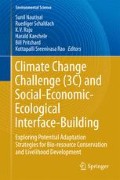Abstract
Think of the time when the first Homo sapien was born. What did we know about the world or the universe or the galaxy at that time? Not even what a three or four years old child of today knows. Probably, this world was restricted to basic needs and surroundings. During those days, managing bioresources conservation and livelihood development was very easy. Slowly but steadily, we started to know the difference between doubt and belief. To satisfy our doubts, therefore, it is necessary that a method should be found to manage bioresources conservation and livelihood development by which our beliefs may be determined by nothing human, but by some external permanency by something upon which our thinking has no effect. Science is the systematic observation of natural events and conditions in order to discover facts about them and to formulate laws and principles based on these facts, theories to make unequivocal predictions that can be tested by anybody. The results can be reproduced by others; the systematic observation of natural events and conditions in order to discover facts about them and to formulate laws and principles based on these facts therefore, managing bioresource conservation and livelihood development unlike other three methods of knowing, the knowledge generated through method of social science is amenable to testing. The sociological scientific approach has been developed with a set of assumptions that cannot be proved. This will also help in understanding the superiority of scientific method over other methods to manage bioresources conservation and livelihood development. The nature is orderly and regular. The state of knowledge is a relative term to manage bioresources conservation and livelihood development what we know today may be disproved tomorrow. The man/woman has been restless, inquiring, and soul searching because he/she knows the power of knowledge. The process of research to manage bioresource conservation and livelihood development starts with problem identification, setting objectives, formulating hypothesis, finalizing research design, determining measurement processes, collecting data, analyzing data, and finally making generalization. When earlier social researchers first started to use research method as means of knowing, i.e., knowing with objectivity without any subjectivity, they started with anthropological type of research where in, they were interested to know what is where to manage bioresources conservation and livelihood development. Exploratory Research what is where? Descriptive Research what is what? Explanatory Research what causes which effect? Experimental Research what is the extent of effect under controlled causal condition? However, Narayana’s innovation attributes Lotus Model explains bioresources conservation and livelihood development research must have relative advantage, compatibility, practicability and complexity. One of the goals is description and other goals being prediction and explanation. Demarcating the research field into manageable parts by dividing the main problem into subproblems is of the utmost importance. SMART can help you critically evaluate the objectives you have set. For every objective, ensure it meets the following criteria: Specific, Measurable, Achievable, Realistic, Time limited. In India, most of the researchers do not report the hypothesis formulated in their studies on managing bioresources. It raises a serious doubt whether the researcher formulate hypothesis for their research or not. One of the important purposes that this blueprint serves is to help draw causal inferences. The idea of causality is central to most of the scientific investigations. To conclude there is need for capacity building among professional, i.e., Narayana’s Wheel Model explains seven orchestrated, concerted, comprehensible like innovativeness, decision-making ability, achievement motivation, information seeking ability, risk taking ability, coordinating ability, and leadership ability for capacity building.
Access this chapter
Tax calculation will be finalised at checkout
Purchases are for personal use only
Author information
Authors and Affiliations
Corresponding author
Editor information
Editors and Affiliations
Rights and permissions
Copyright information
© 2016 Springer International Publishing Switzerland
About this chapter
Cite this chapter
Narayana Swamy, B.K., Nagaraju, Y. (2016). Methodological Issues in Social Science Research for Bioresource Conservation and Livelihood Development Under Global Climate Change. In: Nautiyal, S., Schaldach, R., Raju, K., Kaechele, H., Pritchard, B., Rao, K. (eds) Climate Change Challenge (3C) and Social-Economic-Ecological Interface-Building. Environmental Science and Engineering(). Springer, Cham. https://doi.org/10.1007/978-3-319-31014-5_5
Download citation
DOI: https://doi.org/10.1007/978-3-319-31014-5_5
Published:
Publisher Name: Springer, Cham
Print ISBN: 978-3-319-31013-8
Online ISBN: 978-3-319-31014-5
eBook Packages: Earth and Environmental ScienceEarth and Environmental Science (R0)

